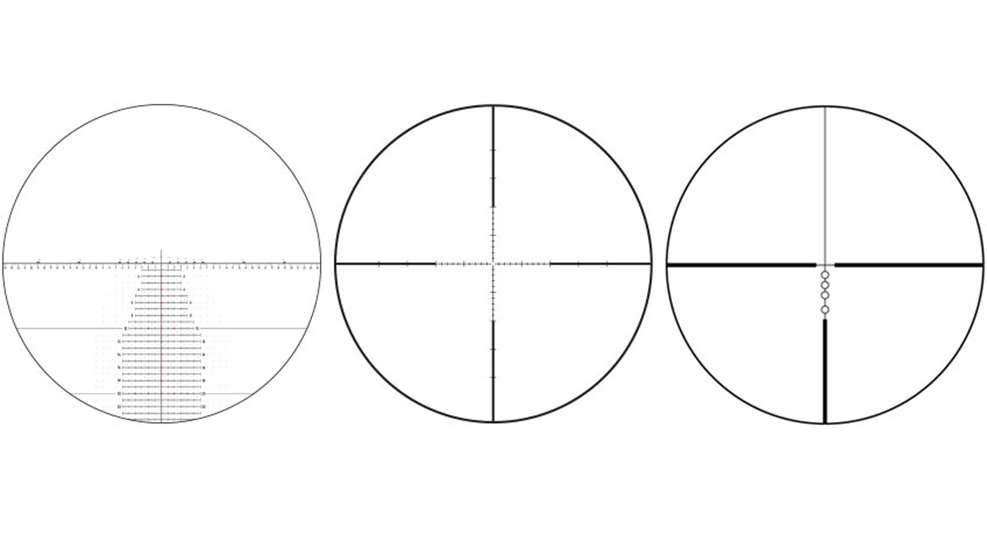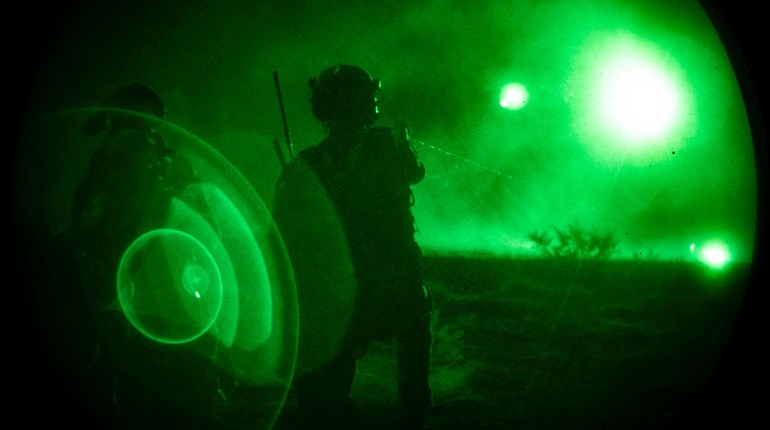
Whether using a Horus-type scope reticle, a mil- or MOA-dot style or a particular bullet-drop compensating (BDC) variety, learning how to properly read, understand and use the gradations, dots and stadia lines on riflescope reticles can make shooting at longer ranges faster and more accurate without having to twist turrets.
I cut my teeth on magnified rifle optics back when you handled any needed elevation and windage adjustments via the scope’s knobs or by using simple “Kentucky windage.” The BDC (Bullet Drop Compensating) reticles back then—as now—were principally designed for one cartridge and only worked marginally well for anything else. The mil-dot scope reticle was as fancy as we got in military circles, but the old workhorse was ignored, shunned or outright disdained by just about everyone else. While most of us were taught to use our “mils” for range estimating and for minor wind corrections, we still dialed in our elevation corrections using external scope knobs.
The “Combat Zero” concept was taught but not heavily practiced. In this case, the optic is zeroed for a set distance, and mil dots above and below center are employed as aiming points for targets closer or farther than zero distance. Standard mil-dot reticles were not accurate enough for high-precision shots using this technique. If the elevation hold did not happen to be on an even mil, the shooter was left to guess where an in-between hold value (3.6 mils for example) was along a stadia line that only had large dots on it, spaced 1 mil apart. That’s akin to measuring something with a ruler that is blank in-between each 1-inch increment.
The problem with dialing-in elevation corrections for distant targets is it only works well when you are not in a hurry. One simple exposure to multiple targets, appearing rapidly from different directions and ranges quickly illuminates the weaknesses of relying on scope knobs. Whether you come off the scope to look at your knob markings for each distance or count a bunch of clicks [up and down] in your head, neither technique holds up under high-stress situations. This is especially true if you have to communicate with team members, take multiple accurate shots, displace to a new location, identify and range more targets and avoid getting shot/rocketed/mortared all the while.
When riflescopes with Horus Vision reticles came into my sniper team’s possession in early 2002, one of my mates learned how to use the Horus reticle system and then quickly schooled the rest of us. We finally had a way to identify, range and compensate for elevation and windage changes quickly and accurately. We also found that we could engage targets much farther than before because these reticles had more elevation adjustment in them than our scopes’ mechanical adjustments provided. As you can imagine, we never looked back.
Since the Horus reticle system became de rigueur in the tactical rifle optics world a dozen years ago, other companies have developed their own enhancements to the basic mil reticle. Anyone with a need to accurately and rapidly engage targets at multiple ranges can benefit from one of these reticles. For those shooters who prefer minutes-of-angle to mils, some scope makers also offer MOA versions.
These scopes are most effective when their reticles are placed in the first (or front) focal plane (FFP). An FFP reticle’s subtensions—the line-spacing measurements—remain calibrated to the size of the target image at any magnification. Conversely, a second (or rear) focal plane (SFP) reticle’s measurements will only work at one power, usually the maximum. The only alternative when using a SFP scope at different magnifications is to multiply and divide the holds by a factor that changes with each power setting.
While old-school shooters have to rewire their brains and break old habits to learn reticle-hold techniques, new shooters learn them quickly. Once mastered, these techniques drastically shorten the time from target identification and ranging to engagement. Best of all, you no longer need to remember to dial your scope back to the starting point after shooting a particular distance, because the elevation and windage knobs are never touched after you zero the scope to your rifle.
So what’s not to like about enhanced tactical reticles? At first glance they often appear too “busy,” and some folks worry that they may get lost in the heat of the moment. It’s a valid concern, and it happens to nearly everyone at least once. Fortunately, if you train with your optic and rifle ahead of actually needing them, you will get to learn from this mistake during practice. I’ve worked with a few rifle shooters who simply could not make the transition to reticle holds and preferred to keep using their knobs the old-fashioned way. The good news is that a fancy reticle does not stop you from using your knobs. Funny enough, shooters also get confused periodically when dialing in corrections.
First-shot misses happen sometime. A cool side benefit of enhanced reticles is that they give you the ability to quickly correct a miss—so long as it was observed through your scope or one with the same reticle graduations as yours. Any observed impact or projectile trace can be measured from the original aiming point by using the reticle’s grid and then quickly corrected for. Second-shot misses are very rare with the right reticle and good techniques.
If you are in the market for new glass, give consideration to a scope with an enhanced reticle. I have only scratched the surface of all the tools a mil-based reticle gives you. Whether it’s a Horus, Bushnell G series, Leupold TMR or one of the many other upgrades to the mil dot, it will enhance what you and your rifle can do together.




































